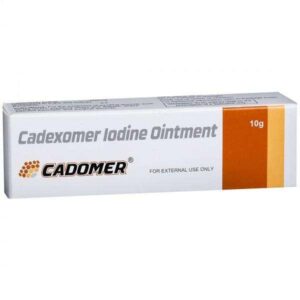CADEXOMER IODINE
CADEXOMER IODINE: CADEXOMER IODINE is a drug primarily used for the treatment of non-healing wounds, ulcers, and skin infections. It comes in the form of an ointment or gel and contains iodine in the form of a complex with cadexomer, which helps to deliver the iodine to the affected area.
The mechanism of action of CADEXOMER IODINE involves the release of iodine gradually over time. Iodine has broad-spectrum antimicrobial activity, meaning it is effective against a wide range of bacteria, viruses, fungi, and protozoa. It works by interfering with the functioning of microbial cells, leading to their death. Furthermore, cadexomer helps to create a moist environment that supports wound healing.
The recommended dose of CADEXOMER IODINE varies depending on the severity and location of the wound or infection. It is typically applied topically to the affected area once or twice daily. It is important to follow the instructions of a healthcare professional or the product labeling for the specific recommended dose.
Like any medication, CADEXOMER IODINE can cause side effects. Common side effects of its use include local skin irritation, itching, burning sensation, or redness at the application site. Some individuals may experience an allergic reaction to iodine-containing compounds, which can manifest as rash, itching, difficulty breathing, or swelling of the face, lips, or tongue. If any of these side effects occur, it is important to discontinue use and seek medical attention.
It is crucial to note that CADEXOMER IODINE should not be used on individuals with a known allergy to iodine or those with thyroid disorders, as excessive iodine absorption may lead to adverse effects on thyroid function. Additionally, it should not be used on deep or puncture wounds, or on wounds with exposed tendons, nerves, or blood vessels. Pregnant or breastfeeding women should consult a healthcare professional before using CADEXOMER IODINE.
Overall, CADEXOMER IODINE is a topical medication used for the treatment of non-healing wounds, ulcers, and skin infections. It works by gradually releasing iodine to kill microbes and creating a moist wound-healing environment. While it is generally well-tolerated, individuals should be aware of potential side effects and seek medical advice if needed.

